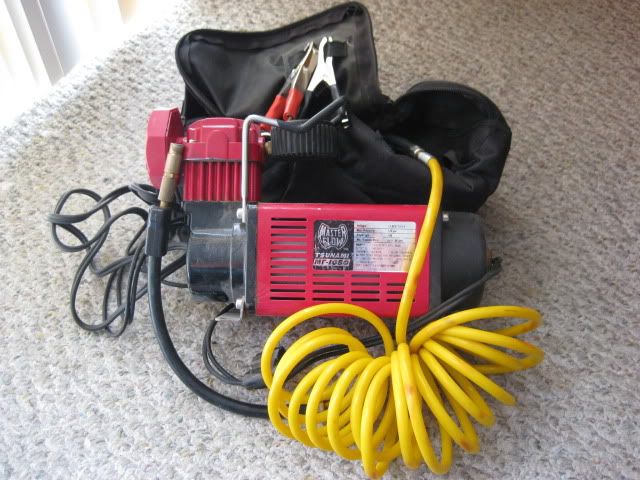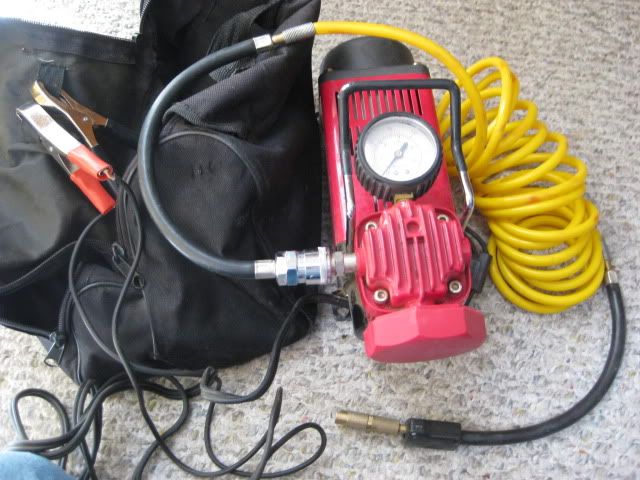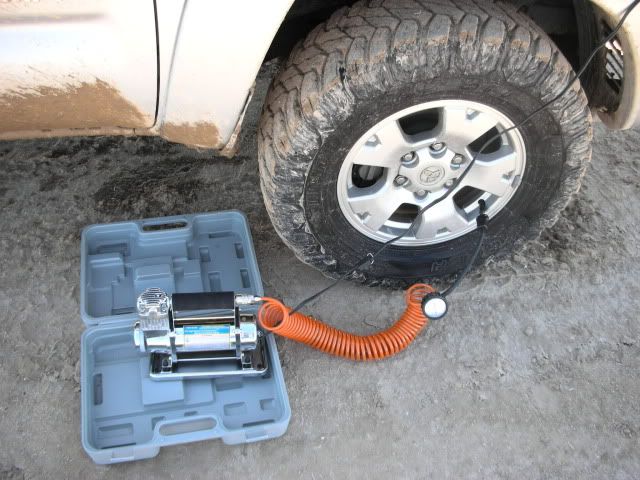| Pages:
1
2
3 |
monoloco
Elite Nomad
     
Posts: 6667
Registered: 7-13-2009
Location: Pescadero BCS
Member Is Offline
|
|
Except for long road trips, I have kept the pressure of the Yokohama Geolanders on my F-350 at 25 psi since new. They now have 25,000 mi on them and I
haven't had one flat or any other problem. The truck does well in sand and rides much smoother on the crappy local roads.
"The future ain't what it used to be"
|
|
|
SFandH
Elite Nomad
     
Posts: 7378
Registered: 8-5-2011
Member Is Offline
|
|
Any advice for a good 12 VDC compressor to "air-up"?
|
|
|
David K
Honored Nomad
        
Posts: 65265
Registered: 8-30-2002
Location: San Diego County
Member Is Offline
Mood: Have Baja Fever
|
|
One that clips onto the battery, not plugs into the cigarette lighter...
The MV-50 or MF-50 is one... and inexpensive... http://www.amazon.com/Industries-MV50-SuperFlow-High-Volume-...


The Harbor Freight one is a bit cheaper, but melts the fuse holder...

[Edited on 3-2-2015 by David K]
|
|
|
AKgringo
Elite Nomad
     
Posts: 6198
Registered: 9-20-2014
Location: Anchorage, AK (no mas!)
Member Is Offline
Mood: Retireded
|
|
I use a Stanley combination compressor jump starter (sorry, no image), which also has 12v and USB outlets, and an LED light.
I was able to bring all four tires up from 12 to 26 psi (four or five mins/tire), and still have enough juice to jump a Suburban long enough to find
out there were problems other than a dead battery.
It is compact, durable, and with the 12v to 110v inverter I carry, it is a hell of a battery for watching movies on my laptop in camp. When I start
driving again, the inverter charges up the battery pack. I love it!
If you are not living on the edge, you are taking up too much space!
"Could do better if he tried!" Report card comments from most of my grade school teachers. Sadly, still true!
|
|
|
dizzyspots
Senior Nomad
  
Posts: 603
Registered: 9-22-2008
Location: Mescal AZ
Member Is Offline
Mood: rather be on the beach at Gonzaga
|
|
Dittoes....have used the MV50..for years...very durable airs up my Tundra tires easy peasy
|
|
|
SFandH
Elite Nomad
     
Posts: 7378
Registered: 8-5-2011
Member Is Offline
|
|
The MV50 is now on my Amazon wish list. Thanks for the recommendations.
|
|
|
Floatflyer
Nomad
 
Posts: 312
Registered: 2-15-2009
Location: Whidbey Island, WA
Member Is Offline
Mood: Wet & Cold
|
|
Anybody appreciate the automatic warning some vehicles(our 2005 Ford Explorer) give you with the GD tire sensors when pressure is reduced? Me either!
|
|
|
David K
Honored Nomad
        
Posts: 65265
Registered: 8-30-2002
Location: San Diego County
Member Is Offline
Mood: Have Baja Fever
|
|
Quote: Originally posted by Floatflyer  | | Anybody appreciate the automatic warning some vehicles(our 2005 Ford Explorer) give you with the GD tire sensors when pressure is reduced? Me either!
|
TPMS (tire pressure monitoring system) is great to warn you when you get a flat before you feel it driving off road... gives you a chance to stop and
see/ hear the air rushing out before the tire is totally flat... so you can roll to the best point to use your tire hole plug kit (another reason to
have an air pump with you). Of course, when you deflate for sand the light comes on, but you can reset it at the lower pressure if you want to turn it
off.
|
|
|
Floatflyer
Nomad
 
Posts: 312
Registered: 2-15-2009
Location: Whidbey Island, WA
Member Is Offline
Mood: Wet & Cold
|
|
I also hated idiot lights when they became common place. Automatic seatbelts, etc! Dinosaur tendencies, yep!!
|
|
|
David K
Honored Nomad
        
Posts: 65265
Registered: 8-30-2002
Location: San Diego County
Member Is Offline
Mood: Have Baja Fever
|
|
I hear you... but, technology happens and while I am an old timer in many ways, I love the tech stuff we have now (GPS, A-TRAC, Blue Tooth, etc.).
Look at how flying navigation is changing... compass to VOR to GPS! Man if those satellites ever fail, we are in a world of hurt!! LOL
|
|
|
geoffff
Senior Nomad
  
Posts: 710
Registered: 1-15-2009
Member Is Offline
|
|
Thanks, DavidK, for the sand driving pics & examples!
If it's late & I'm tired after a full day of driving & I just want to get out onto a beach (such as Sand Island) & camp, I'm sometimes
lazy and try to drive full PSI in the sand -- and it often works for a while (giving it lots of gas), but if I notice *any* tire spinning, I
immediately stop and air down. If I do so before my tires dig in, I can usually just keep going from there without doing any shoveling. 4x4,
lockers, and lots of power make it easy to bury all four wheels down deep until your undercarriage is resting on the sand.
Airing down increases the tire contact area. The same vehicle weight spread over twice the rubber area means the ground needs to support only half
the weight at any given point.
I drive a large van (just shy of 10,000 lbs). I usually run 50 PSI highway, air down to 35 for Baja washboard dirt (for vastly improved ride quality
on the bumps), and air down to 20 PSI for sand. I keep my speed < 50 MPH on dirt and regularly check my tires for overheating from sidewall flex.
My vehicle has an onboard compressor, but it still takes me about 30 minutes to pump up all four tires to full pressure. So I sometimes get lazy
about airing down.
-- Geoff
|
|
|
David K
Honored Nomad
        
Posts: 65265
Registered: 8-30-2002
Location: San Diego County
Member Is Offline
Mood: Have Baja Fever
|
|
You have an awesome Baja rig, geoffff!
|
|
|
redhilltown
Super Nomad
   
Posts: 1130
Registered: 1-24-2009
Location: Long Beach, CA
Member Is Offline
|
|
I think DK briefly touched on it but an accurate tire pressure gauge is REALLY important...many of them are cheap and can be significantly off...I
wouldn't trust the ones on the compressors...yeah, they can be accurate but better to double check with a good one.
|
|
|
POPEYE-SCOTT
Newbie
Posts: 20
Registered: 3-23-2014
Location: Washington
Member Is Offline
|
|
Great read DK... I'm learning a lot. The pump you have looks similar to my craftsman. But the craftsman pump side looks smaller. My dually tires run
80 front and 65 rear. Yesterday I tested my front down to 20 psi.... looks to low for me, I'll test 30 psi when I get to Baja. The pump brought it up
to 50-55 in 3 or 4 minutes, that last part to 75 psi was hard pull, pump end getting pretty warm. So when I pump back up I'll limit it to 55 or so,
and do full pump back when a large compressor is available. In the meantime I just bought that amazon pump, price is low enough for a back-up and they
are small.
|
|
|
David K
Honored Nomad
        
Posts: 65265
Registered: 8-30-2002
Location: San Diego County
Member Is Offline
Mood: Have Baja Fever
|
|
This one looks like a good one (0-60): http://www.amazon.com/Longacre-50417-0-60-Pressure-Gauge/dp/...
|
|
|
PaulW
Ultra Nomad
    
Posts: 3113
Registered: 5-21-2013
Member Is Offline
|
|
Gauge
Most of us use a tire deflator the comes with an accurate gauge. Makes it much easier to deflate accurately and quickly. Here is an example, and is
the the one I have been using to the last 10 years.
http://www.ebay.com/bhp/tire-deflator
When I go on a Jeep club trip either here in Baja or in Colorado 90% of the rigs use that unit on the link.
For normal tire pressure checking I use and electronic one bought at the local auto store. They all seem to be very accurate regardless of the brand.
They eventually die due to dead internal battery and have to be replaced.
For pressurizing I have a CO2 tank in two of my rigs and a VIAIR system in another. Advantages and disadvantages for both. For in my Colorado Jeep I
carry the HF as a backup for the CO2 for trips to Moab where we spend 7 days of deflating and inflating and it limits how many uses for the CO2.
Speed wise CO2 beats everything except the air conditioning compressor setups. No electric pump is anywhere close to CO2 speed wise. Really nice when
I have to deal with the F350 after stealing the CO2 tank from my Bronco.
For a CO2 setup DIY is the way to go to cut the cost to something reasonable. Lots of how to in the web.
Different setups for different situations.
The HF unit discussed will work fine for seldom use and low cost and I recommend it.
Paul
|
|
|
durrelllrobert
Elite Nomad
     
Posts: 7393
Registered: 11-22-2007
Location: Punta Banda BC
Member Is Offline
Mood: thriving in Baja
|
|
Nothing to air down
After WWII my uncle, Jack Terry, who owned Yuma Auto Parts and some of his friends built the original dune buggies to run on the Yuma sand dunes. They
used cut down model A's with tractor wheels.

Bob Durrell
|
|
|
willardguy
Elite Nomad
     
Posts: 6451
Registered: 9-19-2009
Member Is Offline
|
|
Quote: Originally posted by PaulW  | Gauge
Most of us use a tire deflator the comes with an accurate gauge. Makes it much easier to deflate accurately and quickly. Here is an example, and is
the the one I have been using to the last 10 years.
http://www.ebay.com/bhp/tire-deflator
When I go on a Jeep club trip either here in Baja or in Colorado 90% of the rigs use that unit on the link.
For normal tire pressure checking I use and electronic one bought at the local auto store. They all seem to be very accurate regardless of the brand.
They eventually die due to dead internal battery and have to be replaced.
For pressurizing I have a CO2 tank in two of my rigs and a VIAIR system in another. Advantages and disadvantages for both. For in my Colorado Jeep I
carry the HF as a backup for the CO2 for trips to Moab where we spend 7 days of deflating and inflating and it limits how many uses for the CO2.
Speed wise CO2 beats everything except the air conditioning compressor setups. No electric pump is anywhere close to CO2 speed wise. Really nice when
I have to deal with the F350 after stealing the CO2 tank from my Bronco.
For a CO2 setup DIY is the way to go to cut the cost to something reasonable. Lots of how to in the web.
Different setups for different situations.
The HF unit discussed will work fine for seldom use and low cost and I recommend it.
Paul |
we use the trailhead deflators, they work great but the military checkpoint kids pull em out of the leather pouch scratch their heads, always sniff
em, they're sure its some kind of mota pipe!
|
|
|
chavycha
Nomad
 
Posts: 373
Registered: 1-20-2014
Member Is Offline
|
|
We've been doing a lot of beach launching of our tin boat. Chevy Trailblazer (a heavy 4500# on 245/70/17) towing a 14' boat on 4.80x12 at 40psi,
weight about 800lbs.
One thing not mentioned much here is that all sand isn't created equal. Flat Pacific side beach sand is usually well-packed and solid. Dunes are
not. Cortez side steep beach sand is marginal. Cortez side about 100 yards from the beach is worst. Dry, loosely packed, yuck.
For beach launching - driving is easier...
Pacific side:
35psi is stuck with 2wd. Fine with 4x4.
28psi and 2wd work on the well-packed beaches, but 4wd most of the time just to be sure.
24psi once on a real soft beach, 4x4 in and out.
Cortez side:
35psi is guaranteed stuck, even with 4x4.
28psi is okay on the beach in front of town with 4x4 hi, unless the sand's soft.
24psi and I don't even have to shift out of 2wd to get the boat to the water. Still have to 4x4 to get it up and out. Doesn't work on the steepest
of beaches. Reaching the point of having to air up to go places afterwards.
12psi and 4x4 low has gotten out of everything (so far), including two beaches with some pretty darn dusty/fine sand and a very steep slope. Just
barely on one, but just barely is just good enough.
[Edited on 3-4-2015 by chavycha]
|
|
|
MitchMan
Super Nomad
   
Posts: 1856
Registered: 3-9-2009
Member Is Offline
|
|
Don't take this as advice, but, I used to use those cheap hand held tire pressure gauges but I never really felt that they were reliable. Never had a
vehicle with beefy off road tires.
Without deflating the tire, it seemed that I would get a wildly different reading depending on fast I stuck that gauge on the tire's valve stem. That
is because, if you got it right quickly, that shock of air would push the calibrated stem out really fast...and too far out due to increased momentum
due to speed that the stem would be pushed out. You know, speed x weight = momentum.
Also, I always thought the recommended tire pressure was always a bit high as it was probably intended to reflect smooth USA paved freeways and roads
as opposed to rough Mexico roads at lower speeds.
So, I use the "thumb test" for a slightly lower than recommended PSI. That means that I quickly press my thumb on the side of a tire at rest to
determine if the tire needs air and I can judge the right amount of tire pressure that I prefer pretty accurately. Don't have to kneel at each tire,
don't have to unscrew and re-screw the valve stem cap, and it's ten times faster.
Works for me as it's easy to tell which tire is lowest of the four and which is the most pressurized of the four. Also, by looking at the bulge on
the side of the tire at rest, it's also easy to guess if the tire pressure is way too low. Furthermore, as mentioned in this thread, lower than
recommended PSI provides a smoother ride and rolling over debris and small rocks is less damaging. It's a win win.
When I was a cook, we used to test the doneness of steaks...hundreds of them...by a quick poke of the cooking steak with your index finger. Lots of
sensitivity in the fingers. Works on steaks, works on tires.
[Edited on 3-5-2015 by MitchMan]
|
|
|
| Pages:
1
2
3 |

